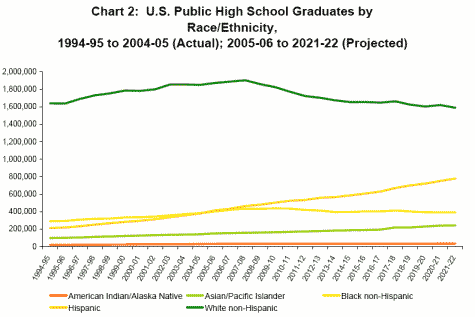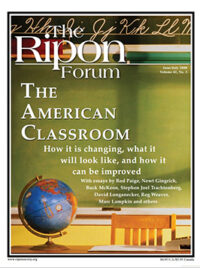Wow, is the face of the American student changing. Recently, the Western Interstate Commission for Higher Education (WICHE), of which I am the President, published its seventh edition of Knocking on the College Door.
This report examines recent enrollment trends of students enrolled in and graduating from high school in each of the fifty states by race/ethnicity, and projects enrollments and graduations for the next fifteen years based on current population and participation trends.
If you haven’t been paying close attention to the changing demographic characteristics of students in your state or region, you may find some of these current statistics and projections for the future to be quite startling. Two themes dominate these trends: (1) changes in the overall population of students from state to state, region to region, and for the country as a whole, and (2) the escalating diversification amongst these students, with these changes differing substantially again from state to state, region to region, and in the aggregate.
As reflected in Chart 1, this year’s high school graduating class will be the largest in the history of our country, capping nearly two decades of continuous and substantial growth. For at least the next decade, however, we can expect the number of high school graduates, all else being equal, to decline gradually, after which they will again begin to rise until the number peaks in about 2020 at roughly the same level it will be this year.
The kicker, of course, is that casually stated assumption, “all else being equal,” because we do not project the likely effects, intended or not, of changes in policy or practice that might impact these estimates. For example, if the federal No Child Left Behind program has the intended effect of increasing the success of students in completing high school, our projections will prove too low. On the other hand, if the financial difficulties many states and the federal government are experiencing lead to reductions in the support of education, our projections could turn out to be too high.
…today 37% of high school graduates (projected) come from communities of color.
Nonetheless, it is useful to understand what the likely result of current policy and practice will produce, given the population of students to be served; and our projections suggest that such a scenario for the country as a whole will lead to a modest decline in students; nothing to get exercised over but a pretty significant change in the environment compared to what the country has experienced in recent years.
These fairly benign changes at the national level, however, hide some much more significant variations from region to region and state to state. The South and West, for example will continue to grow in population, initially quite modestly and then more rapidly, whereas both the Northeast and Midwest will decline (Chart 1). Within each region, however, we find more significant likely variations in enrollment and graduation trends than we see between regions. Arizona and Nevada, both Western states, are projected to face the most rapid increases over the next decade (34 and 37 percent respectfully), whereas the two states with the largest projected declines in enrolment and graduates, Vermont and North Dakota, will see declines of 23 and 19 percent over the same time period.

While the challenges facing these two scenarios differ greatly in nature, they differ little in significance. In a state facing rapid growth, it will be extremely difficult to provide the public funds necessary to sustain current levels of funding on a per student basis, thus quality may be at risk. And in a state facing a substantial decline, particularly a state that already suffers from the absence of economies of scale in rural schools, it will be difficult to sustain a quality experience even if funding on a per student basis can be maintained.
If we don’t improve our success in serving these emerging population, not only will our education systems fail us, but the entire fabric of our society will be at risk…
So, overall, the states fall roughly into three categories: those that will face modest increases or decreases that should be quite manageable in public policy terms; those that will face more significant increases or decreases that will require quite intentional changes in public policy; and those that will face such substantial increases or decreases that only quite radical departures from current policy and practice will meet the magnitude of the challenges these states face.
These overall trends, however, are not the real WOW factor in this story. The huge story is in the demographic composition of these students. As noted in Chart 2, today 37% of high school graduates (projected) come from communities of color. A decade from now we project that share will have increased to 46%, with virtually all of the growth coming from increases in Hispanic/Latino students. In fact, the number of Black and Anglo students will actually decline.

As with the aggregate statistics, however, these trends vary substantially from region to region and state to state. The West, for example, will become majority minority in the high school graduating class of 2010, with the South following in 2017. California, Hawaii, New Mexico, Texas and the District of Columbia already fit that descriptions, and Arizona, Florida, Georgia, Maryland, Mississippi, and Nevada will gain this distinction within the next eight years. In all of these states, increases in Hispanic/Latino students are driving these trends.
These changes have significant implications for all of education, but particularly for higher education. Simply put, higher education currently serves best those students who are becoming a smaller portion of our population and serves least successfully those populations that are growing most rapidly. If we don’t improve our success in serving these emerging populations, not only will our education systems fail us, but the entire fabric of our society will be at risk because our nation’s competitiveness in an increasingly global knowledge-based economy requires that we achieve higher levels of educational attainment than ever before, and our ability to do so will rest on these new majority students who we have traditionally not been successful in serving.
Yet it is not only these trends in newly minted high school graduates that is changing American higher education. Today, the face of American higher education is getting much older. More than one-third of today’s 17½ million college students are 25 years of age or older, and this group is projected by the National Center for Education Statistics (NCES) to grow by nearly 20 percent over the next decade. The challenges facing these students are often as great as those facing the growing number of young students from groups that higher education has traditionally not served well. Adults face a college environment still designed for the full-time young adult. As a result, they often face class schedules, faculty expectations, and curricular requirements that simply don’t make sense for a seasoned adult who has gained knowledge in a variety of ways and faces unique family and other adult constraints that are not well accommodated in many college environments.
Yet, the evidence is clear that to remain economically competitive America will need to do a better job of educating not only the new and changing young entrants to college, but also these older adults, many returning for a second chance at college and the world of work and others continuing their education for the first time.
So, higher education has both a challenge and a responsibility. The challenge is to change in ways that better serve the new and different faces of their student bodies Both our public and private institutions of higher education must do this well for all Americans, not only because that is their “public trust” responsibility, but also because America’s future depends on it.
David A. Longanecker is the president of the Western Interstate Commission for Higher Education in Boulder, Colorado. Previously he served for six years as the assistant secretary for postsecondary education at the U.S. Department of Education.




